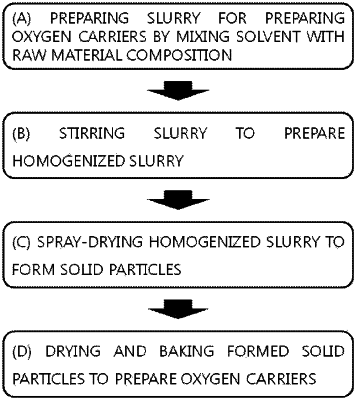| CPC F23C 10/10 (2013.01) [B01J 8/1872 (2013.01); B01J 8/228 (2013.01); C01B 13/02 (2013.01); C01B 13/08 (2013.01); C01B 13/20 (2013.01); C04B 35/01 (2013.01); C04B 35/626 (2013.01); C04B 35/6263 (2013.01); C04B 35/62655 (2013.01); C04B 35/62675 (2013.01); C04B 35/632 (2013.01); C04B 35/634 (2013.01); C08L 29/04 (2013.01); C08L 71/08 (2013.01); F23L 7/007 (2013.01); C04B 2235/322 (2013.01); C04B 2235/3206 (2013.01); C04B 2235/3218 (2013.01); C04B 2235/3222 (2013.01); C04B 2235/3227 (2013.01); C04B 2235/3232 (2013.01); C04B 2235/3279 (2013.01); C04B 2235/44 (2013.01); C04B 2235/528 (2013.01); C04B 2235/5427 (2013.01); C04B 2235/5436 (2013.01); C04B 2235/5463 (2013.01); C08L 1/28 (2013.01); F23C 2900/99008 (2013.01); F23J 2215/50 (2013.01)] | 23 Claims |

|
1. A raw material composition for producing oxygen carriers by spray-drying method, the raw material composition to be calcinated comprises 55 parts by weight to 80 parts by weight of nickel hydroxide, 15 parts by weight to 40 parts by weight of boehmite, and 3 parts by weight to 15 parts by weight of magnesium oxide or magnesium hydroxide, thereby lowering the calcination temperature for improving oxygen transfer performance,
wherein the oxygen carriers are formed by calcination after the spray-drying, and
wherein when the calcination temperature is 1200° C., the oxygen carriers have an oxygen transfer capacity of 12.5 parts by weight to 25 parts by weight based on the total weight of the oxygen carriers and have a wear index obtained by Equation 1 below of 20% or lower:
AI (%)=[(W2)/(W1)] [Equation 1]
In Equation 1, W1 represents a weight in g of a sample before the wear test, and W2 represents a weight in g of fine particles captured during the 5 hours of the wear test,
the wear test is conducted for 5 hours at a flow rate of 10.00 l/min (273.15 K, 1 bar) according to ASTM D5757-95 from the American Society for Testing Materials (ASTM) using a wear tester.
|